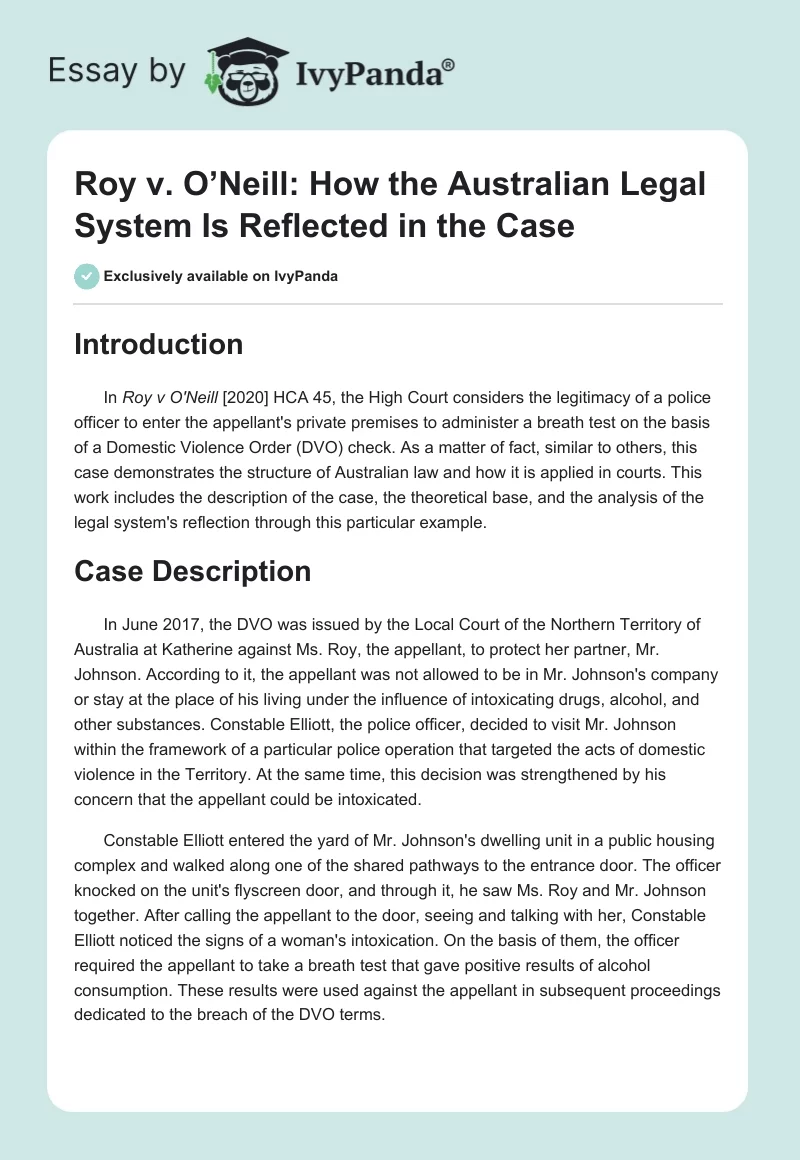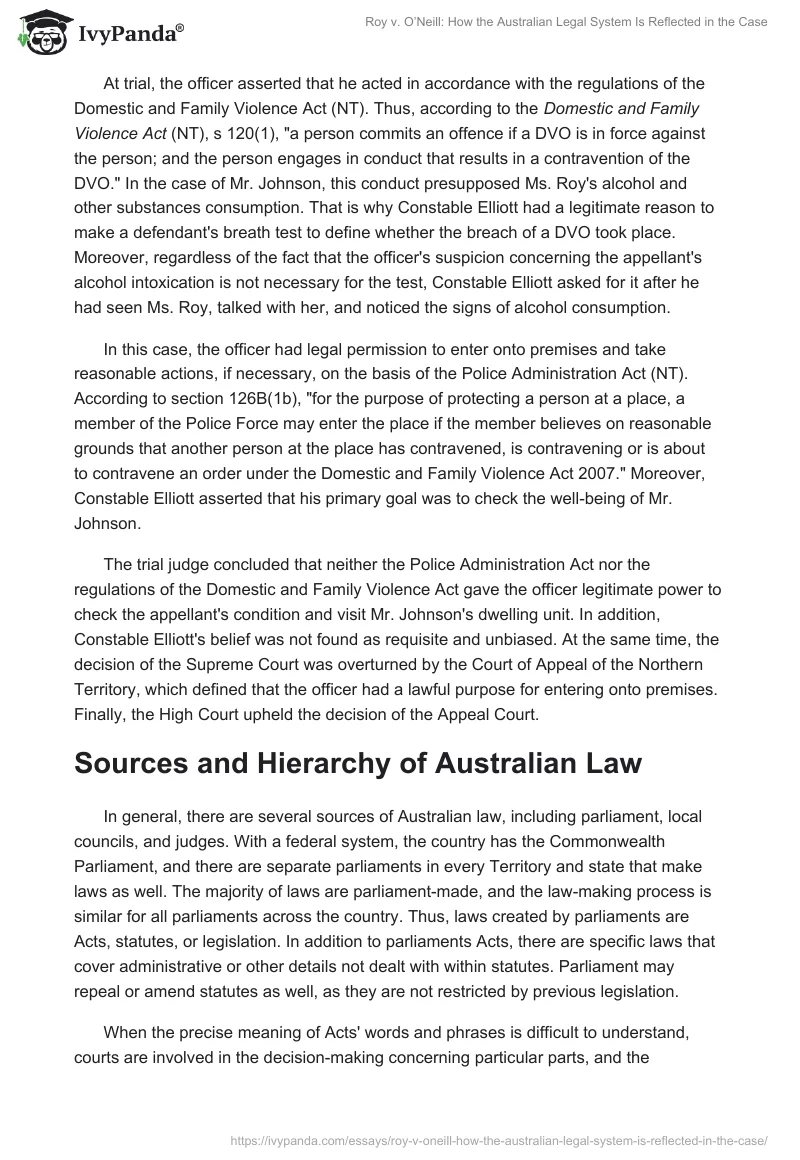Introduction
In Roy v O’Neill [2020] HCA 45, the High Court considers the legitimacy of a police officer to enter the appellant’s private premises to administer a breath test on the basis of a Domestic Violence Order (DVO) check. As a matter of fact, similar to others, this case demonstrates the structure of Australian law and how it is applied in courts. This work includes the description of the case, the theoretical base, and the analysis of the legal system’s reflection through this particular example.
Case Description
In June 2017, the DVO was issued by the Local Court of the Northern Territory of Australia at Katherine against Ms. Roy, the appellant, to protect her partner, Mr. Johnson. According to it, the appellant was not allowed to be in Mr. Johnson’s company or stay at the place of his living under the influence of intoxicating drugs, alcohol, and other substances. Constable Elliott, the police officer, decided to visit Mr. Johnson within the framework of a particular police operation that targeted the acts of domestic violence in the Territory. At the same time, this decision was strengthened by his concern that the appellant could be intoxicated.
Constable Elliott entered the yard of Mr. Johnson’s dwelling unit in a public housing complex and walked along one of the shared pathways to the entrance door. The officer knocked on the unit’s flyscreen door, and through it, he saw Ms. Roy and Mr. Johnson together. After calling the appellant to the door, seeing and talking with her, Constable Elliott noticed the signs of a woman’s intoxication. On the basis of them, the officer required the appellant to take a breath test that gave positive results of alcohol consumption. These results were used against the appellant in subsequent proceedings dedicated to the breach of the DVO terms.
At trial, the officer asserted that he acted in accordance with the regulations of the Domestic and Family Violence Act (NT). Thus, according to the Domestic and Family Violence Act (NT), s 120(1), “a person commits an offence if a DVO is in force against the person; and the person engages in conduct that results in a contravention of the DVO.” In the case of Mr. Johnson, this conduct presupposed Ms. Roy’s alcohol and other substances consumption. That is why Constable Elliott had a legitimate reason to make a defendant’s breath test to define whether the breach of a DVO took place. Moreover, regardless of the fact that the officer’s suspicion concerning the appellant’s alcohol intoxication is not necessary for the test, Constable Elliott asked for it after he had seen Ms. Roy, talked with her, and noticed the signs of alcohol consumption.
In this case, the officer had legal permission to enter onto premises and take reasonable actions, if necessary, on the basis of the Police Administration Act (NT). According to section 126B(1b), “for the purpose of protecting a person at a place, a member of the Police Force may enter the place if the member believes on reasonable grounds that another person at the place has contravened, is contravening or is about to contravene an order under the Domestic and Family Violence Act 2007.” Moreover, Constable Elliott asserted that his primary goal was to check the well-being of Mr. Johnson.
The trial judge concluded that neither the Police Administration Act nor the regulations of the Domestic and Family Violence Act gave the officer legitimate power to check the appellant’s condition and visit Mr. Johnson’s dwelling unit. In addition, Constable Elliott’s belief was not found as requisite and unbiased. At the same time, the decision of the Supreme Court was overturned by the Court of Appeal of the Northern Territory, which defined that the officer had a lawful purpose for entering onto premises. Finally, the High Court upheld the decision of the Appeal Court.
Sources and Hierarchy of Australian Law
In general, there are several sources of Australian law, including parliament, local councils, and judges. With a federal system, the country has the Commonwealth Parliament, and there are separate parliaments in every Territory and state that make laws as well. The majority of laws are parliament-made, and the law-making process is similar for all parliaments across the country. Thus, laws created by parliaments are Acts, statutes, or legislation. In addition to parliaments Acts, there are specific laws that cover administrative or other details not dealt with within statutes. Parliament may repeal or amend statutes as well, as they are not restricted by previous legislation.
When the precise meaning of Acts’ words and phrases is difficult to understand, courts are involved in the decision-making concerning particular parts, and the interpretation of a court may be regarded as judge-made law. In general, courts cannot challenge or overrule Acts unless they are unconstitutional and are not placed foremost by the federal or state parliament. In this case, judges may declare such Acts or their parts as inefficient or invalid. In turn, parliaments have the power to overturn the court’s interpretation of an Act or the decision made on its basis.
At the same time, judges in Australia are still bound by a considerably strong tradition to apply decisions made earlier to similar cases in the present. Even if the facts and evidence of previous cases were not identic, the court may develop a new though similar principle or apply a common one while comparing both situations. This approach is called the doctrine of precedent, and the rules and principles on the basis of judges’ decisions are defined as the common law.
Thus, according to its hierarchy, Australian law may be divided into the Constitution-based Commonwealth legislation, the High Court and Federal Courts’ decisions on the basis of the Commonwealth legislation’s interpretation, the legislation of states and territories, and the related decisions of local courts. In addition, the High Court of Australia may resolve disputes between federal and state law when the former traditionally prevail. Generally, in the Australian court structure, the decisions of the High Court are final, and no subsequent appeals are possible. Finally, statutes always override the common law, and the latter is applied only when there is no statute to cover a specific situation.
The sources and hierarchies of Australia observed in the Roy v O’Neill [2020] HCA 45 case. Two main sources of law, including statutes and the common law, are reflected in it. Statutes are represented by the legislation of the Northern Territory’s parliament – the Domestic and Family Violence Act (NT) and the Police Administration Act (NT), while the common law, along with the doctrine of precedents, implied the decisions on the basis of previous similar cases, such as Halliday v Nevill and Robson v Hallett. For instance, according to the common law, there should be an occupier’s permission or invitation for a person to enter private Territory lawfully. At the same time, precedents and Australian society’s peculiarities have developed this statement – permission is not required if there is no indication that entrance is prohibited, and a visitor comes for lawful communication, delivery, or another purpose that does not imply his intention to harm an occupier or damage property. In addition, the hierarchy of law and the prevalence of statutes may be observed in the case as well: regardless of the common law, the Police Administration Act (NT) enabled the officer to enter into premises for Mr. Johnson’s protection as the breach of the DVO had been detected.
Law Enforcement and Dispute Resolutions
In Australia, the rule of law presupposes that no one can be above the law. To be effective, the law is required to be followed by all people in the Territory of the country. Law enforcement may be regarded as an essential component of Australia’s justice system that ensures citizens’ law obedience. Thus, federal, Territory, state, and local law enforcement services are responsible for the protection of the community by upholding the law, preserving the peace, managing emergency incidents, and organizing crime prevention operations. In the Roy v O’Neill [2020] HCA 45 case, law enforcement was represented by the police officer who was participating in the operation dedicated to domestic violence prevention. In addition, it is obvious that legislation supports law enforcement through specific Acts that broaden the police’s mandate in particular situations. However, as previously mentioned, law enforcement also means that no one is above Australian law – thus, the court decided whether the actions of Constable Elliott had been legitimate or not, regardless of his position as the representative of power.
Litigation may be regarded as one of the most common mechanisms of dispute resolution in Australia. The country’s court system has a strict hierarchy – the Supreme Courts of states and territories and the Federal Court comply with the decisions of the High Court. The Court of Appeal is the State court’s appellate division responsible for the supervision of jurisdiction and appeal in the case of one party’s disagreement concerning the Supreme Court’s decision. In this situation, the case is investigated by the High Court, and its decision is final.
This mechanism of dispute resolution is conveniently illustrated in the Roy v O’Neill [2020] HCA 45 case. The Local Court concluded that Constable Elliott had been a trespasser and his entry into Mr. Johnson’s premises had been illegal. However, on the basis of an appeal brought by Sergeant O’Neill, the Court of Appeal overturned the judge’s initial decision. Therefore, the case was sent to the High Court, which finally upheld the decision of the Appeal Court. From a personal perspective, the responsibilities and roles of Australian courts determined by their hierarchy may explain the difference between the majority and minority judges’ views. Thus, Australian courts are bound by the tradition of precedents and the common law that reflects society’s norms and expectations as well, according to which a home is “a castle.” To be precise, they refuse to depart from previous decisions without important reasons. In turn, higher courts consider legislation that overrides the common law and tend to examine each case on the basis of applicable statutes.
Conclusion
As the Australian legal system emphasizes the rule of law and all citizens’ law obedience, its features may be traced in legal cases. Thus, Roy v O’Neill [2020] HCA 45 illustrates the existence of legislation and the common law as the sources of Australian law and the former’s prevalence within the framework of its hierarchy. Moreover, it demonstrates law enforcement and the duty of any community member, regardless of his or her position to answer in law. Finally, it explains how the mechanism of dispute resolution works, especially in the case of an appeal.
Works Cited
“Australia: Litigation & Dispute Resolution Laws and Regulations 2021.”ICLG.com, 2021.
Course Material. 2021.
“Domestic and Family Violence Act 2007.”Northern Territory Government. Web.
“Police Administration Act 1978 – Sect 126B.”Northern Territory Consolidated Acts.
“Roy v O’Neill [2020] HCA 45.”High Court of Australia.


